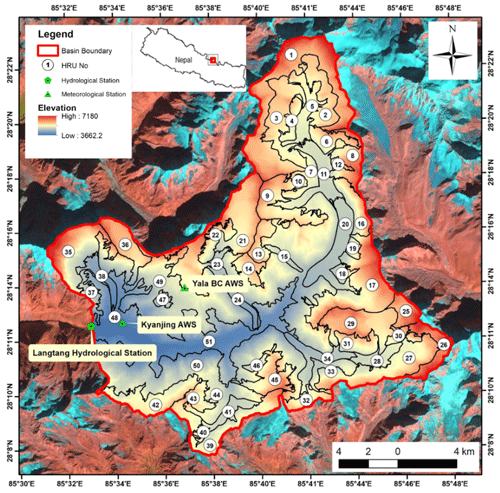the Creative Commons Attribution 4.0 License.
the Creative Commons Attribution 4.0 License.
Impact of changes in climate and glacier configurations on runoff from the Langtang River basin, Nepal
Dhiraj Pradhananga
Susa Manandhar
Bharat Dhungana
Manavi Chaulagain
Bhola Nath Dhakal
Sunil Adhikary
Climate change is rapidly altering Himalayan glaciers, jeopardizing downstream water resources. This study investigates the impact of changing air temperatures, precipitation, and glacier configurations on streamflow in the Langtang River basin, a vital Himalayan basin. Using a process-based glacio-hydrological model driven by bias-corrected reanalysis data, we simulate streamflow under various scenarios. Results reveal that, while current glacier conditions show increased runoff with higher temperatures and precipitation, future deglaciation scenarios project a decrease in total streamflow, highlighting the complex interplay between climate and glacier dynamics in basin hydrology. These findings emphasize the need for adaptation strategies to ensure water security in the face of evolving Himalayan hydrology.
- Article
(3841 KB) - Full-text XML
- BibTeX
- EndNote
Mountain snow and glaciers, nature's frozen reservoirs, play a vital role in maintaining downstream freshwater resources. The storage and release of water depend on climatological factors, making them sensitive indicators of climate change. Rapid changes in climatic conditions have shifted the accumulation and melting patterns of snow field areas and glaciers. Their retreat is impacting water resources across the globe as snow and ice have a strong influence on their basin hydrological regime due to their capacity to store water on seasonal to decadal timescales (Jansson et al., 2003).
Runoff dynamics in glacierized and non-glacierized catchments are very different, and it is challenging to understand the interconnection between meteorological parameters and to incorporate them into the model. Mountain glacierized headwaters are undergoing a transient shift in their hydrological and glaciological systems due to rapid climate change. In this research, we set out to understand how the hydrology and streamflow generation in glacierized basins will be affected due to shifts in air temperature and precipitation patterns.
In glacierized areas, snow and exposed or debris-covered ice play a major role in streamflow generation, but these factors are often neglected in hydrological models (Koboltschnig and Schöner, 2011; van Tiel et al., 2020). For a glacierized basin like Langtang, without the proper modeling approaches, it is very difficult to understand the impact of climate change and the contribution of glaciers to the runoff. While looking at the changes and shifts in glaciers, only meteorological and climatic factors are considered. Physical factors such as land cover are the least considered when estimating the influence of glacier melt in glacier hydrology (Aubry-Wake et al., 2022).
By applying a process-oriented glacial–hydrological model, this study quantifies the evolving influences of on-glacier and off-glacier processes on streamflow generation in the context of future climate scenarios. This approach aims to safeguard freshwater availability from glacierized basins for the well-being of dependent ecosystems and communities.
2.1 Study area
The Langtang River basin (LRB) in the central Himalayas of Nepal plays a vital role in sustaining downstream communities and ecosystems. The LRB lies approximately 100 km north of Kathmandu, bordering between Nepal and China (Fig. 1). It spans from 28°08′ to 28°23′ N latitude and from 85°35′ to 85°48′ E longitude, covering an area of 354 km2. The elevation ranges from 3800 m a.s.l. up to the peak of Langtang Lirung at 7234 m a.s.l, with an average altitude of 5168 m a.s.l, a mean slope of 26.7°, and a predominantly south-facing aspect (mean 193.5°). In 2000, the area of the glacier was 189 km2 (53 %), and the accumulation area ratio (AAR) was 0.8. The main valley, carved by glacial activity into a characteristic U shape, is divided by the Langtang River (Adhikari et al., 2014). Rising concerns about climate change and its potential impact on the LRB's glaciers and water resources motivated this study to investigate the complex interplay between climate, glaciers, and streamflow generation.
2.2 Meteorological and hydrological data
This study utilized both observed and reanalysis meteorological data to drive the Cold Regions Hydrological Model (CRHM). Daily and hourly data from Kyangjing Station (Fig. 2), spanning the periods 2002–2009 and 2012–2019, provide essential information on temperature, precipitation, solar radiation, relative humidity, and wind speed, obtained from the Department of Hydrology and Meteorology (DHM) and the International Centre for Integrated Mountain Development (ICIMOD). Due to limitations in the availability of observed data, we employed bias-corrected reanalysis data from the Water and Global Change (WATCH) forcing data methodology applied to ERA-Interim data (WFDEI, Weedon et al., 2011). WFDEI was chosen for its superior representation of the LRB's climatic conditions compared to other reanalysis datasets (ERA-Interim and MERRA-2), particularly in terms of accurately capturing precipitation patterns and temperature fluctuations. We validated the CRHM model with observed streamflow at Langtang Khola (Fig. 2b).
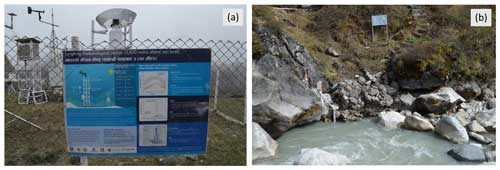
Figure 2Photos showing (a) Kyangjing meteorological station and (b) hydrometric station at Langtang River.
Spatial data such as land cover and soil maps were obtained from the Topographical Survey and Land Use Management Division, as well as from the ASTER Global Digital Elevation Model (DEM), with a resolution of 30 m; these were used to characterize the basin's physical characteristics and to provide inputs for the CRHM Model.
2.3 Cold Regions Hydrological Model (CRHM)
This study employs the CRHM platform (Pomeroy et al., 2022), a flexible framework for developing process-based hydrological models tailored to cold regions and temperate climates. Its modular structure allowed us to incorporate CRHM-Glacier (Pradhananga and Pomeroy, 2022a), a specific model extension equipped with modules for simulating key glacier-related processes like firnification, snow redistribution by wind and gravity, and coupled mass and energy budgets. These features are crucial for accurately representing the complex runoff dynamics of the LRB, influenced by both snowmelt and glacier melt. Figure 3 illustrates the modular structure of CRHM-Glacier, highlighting the specific modules used in this study.
2.4 Methodology
To investigate the impact of climate change and glacier dynamics on LRB streamflow, we adopted a multi-pronged approach. The CRHM-Glacier model built for LRB was considered for the model runs with different possible scenarios. We divided the basin into 51 hydrological response units (HRUs) to capture spatial variations in topography, land cover, and glacier distribution; details are in Pradhananga and Pomeroy (2022a). The bias-corrected WFDEI data of air temperature, humidity, precipitation, wind speed, and incoming shortwave and longwave radiation were used to force the CRHM-glacier. We simulated streamflow from 2008 to 2018 and presented the aggregated values. We conducted sensitivity analyses to assess the model's response to changes in individual parameters. For example, we increased and decreased precipitation values to understand the model's sensitivity to future precipitation variations. We also ran simulations under different future climate scenarios and glacier configurations (similar to Pradhananga and Pomeroy, 2022b) to predict potential changes in runoff patterns under varying temperature and precipitation regimes.
3.1 Glacier configuration
This study employed the CRHM-Glacier to investigate the interplay between glacier configuration and streamflow in the LRB under both present and future climate scenarios. Our key findings highlight the complex changes in runoff patterns resulting from glacier retreat and climatic shifts.
3.1.1 Present climatic scenario
Figure 4a visualizes the simulated daily averaged streamflow for the period 2008–2018 with and without glaciers, representing the LRB's current and deglaciated state. Notably, removing glaciers in the simulation resulted in a 32 % decrease in total annual runoff (Fig. 4b). This finding contradicts the intuitive assumption that more glacier melt would lead to higher runoff. However, it can be attributed to the crucial role glacial ice plays in storing and releasing water over the course of a year. During the warm seasons, meltwater from glaciers supplements streamflow, compensating for reduced snowmelt and mitigating summer droughts. This underscores the vital contribution of glaciers to the LRB's seasonal water balance beyond simply providing additional runoff through melting.
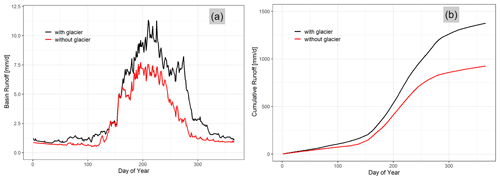
Figure 4Variation in streamflow with and without glaciers in LRB: (a) daily averaged values for the period 2008–2018 and (b) yearly cumulative runoff value.
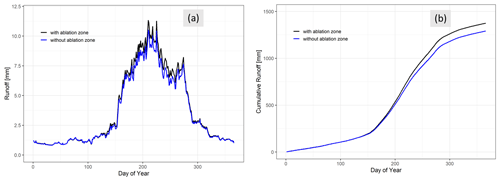
Figure 5Variation in streamflow with and without ablation zone in LRB: (a) daily averaged values for the period 2008–2018 and (b) yearly cumulative runoff value.
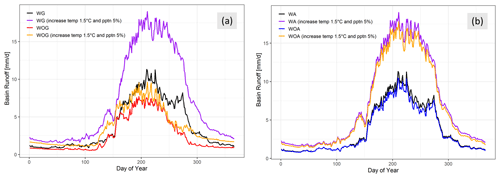
Figure 6Daily averaged values of streamflow for the period 2008–2018 (a) with and without glaciers and (b) with and without ablation zone.

Figure 7Daily averaged simulation of streamflow for the period 2008–2018. (a) Air temperature scenario. (b) Lapse rate scenario.

Figure 8Daily averaged simulation of streamflow for the period 2008–2018. (a) Precipitation scenario. (b) Precipitation gradient scenario.
Figure 5 further explores the impact of the ablation zone, the lowermost region of a glacier. Simulating scenarios with and without an ablation zone, which comprises 10.7 % of the total basin area (representing potential future retreat), suggests a 7 % decrease in total annual runoff. This highlights the importance of preserving the ablation zone to maintain water resources in the face of climate change.
3.1.2 Future climate scenario
There are high projections that the glacier melt would be around 80 % in the worst-case scenarios (IPCC, 2023; Khadka et al., 2020; Prasad et al., 2019). Hence, we are looking into the condition for stabilizing the temperature by 1.5 °C, which might increase the precipitation by 5 %. In Fig. 6a, considering the climatic scenario for the extreme conditions with and without glaciers, there is a decrease in the runoff by −7.9 %. When taking the condition of Fig. 6b, which is, in this case, just the ablation-zone retreat, there would be an increase in runoff by 77 %. The model does show the trend of high runoff during the monsoon and a decrease in runoff to below normal during the dry period, providing a rough estimate that, in the long run, with increasing trends in climate change, the wet period will be wetter, and the dry period will be dryer.
3.2 Sensitivity analysis
To delve deeper into the model's response to individual parameters, we conducted sensitivity analyses for air temperature, lapse rate, precipitation, precipitation gradient, and firn albedo (Figs. 7–9). Notably, the model exhibited the highest sensitivity towards air temperature, with increasing temperature leading to a proportional increase in runoff. This aligns with established knowledge of glacier melt dynamics and its impact on streamflow. Similarly, a decrease in runoff was simulated with an increasing lapse rate. This suggests that, while warming temperatures might initially increase runoff, their impact can be moderated by atmospheric temperature gradients within the basin.
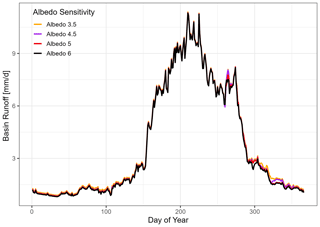
Figure 9Daily average simulation of streamflow with changes in firn albedo scenarios for the period 2008–2018.
The other sensitivity analyses revealed a positive correlation between runoff and precipitation, a moderate sensitivity to the precipitation gradient, and minimal changes with varying firn albedo (Fig. 9).
This study highlights the profound influence of glacier configuration and climate change on streamflow patterns in the LRB. Our findings offer critical insights into the complex interplay between glaciers, temperature, precipitation, and seasonal water availability. The rapid decrease in runoff under complete deglaciation emphasizes the crucial role of glacier storage in maintaining the basin's hydrological balance. Future climate scenarios suggest mixed effects, with potential increases in runoff during wet periods but concerns about further reductions during dry seasons. These findings highlight the urgent need for effective water management strategies that adapt to evolving glacier dynamics and changing climate patterns to ensure water security for downstream communities.
This study utilized a process-based glacio-hydrological model, CRHM-Glacier, to simulate streamflow in the Langtang River basin under various climate and glacier change scenarios. The complete removal of glaciers resulted in a 32 % decrease in total runoff, highlighting the critical role of glaciers in maintaining mountain water resources. Future climate scenarios with increased temperature and precipitation also showed substantial alterations in runoff patterns, with dry seasons becoming drier and wet seasons becoming wetter.
This study further confirmed the positive correlation between precipitation and runoff, highlighting their critical role in shaping basin hydrology. Additionally, sensitivity analyses revealed the influence of the lapse rate, precipitation gradient, and firn albedo on streamflow dynamics. These findings emphasize the urgency of understanding and adapting to the evolving hydrological regime of the LRB for the long-term sustainability of water resources in the region. Further research is essential to understand how glacier dynamics, in combination with regional climate patterns and land-use changes, impact runoff patterns. This understanding is critical for developing informed long-term water management strategies in vulnerable mountainous regions like the Langtang Valley.
The hydrological and meteorological data used for this study are available from the Regional Database System of ICIMOD at https://rds.icimod.org/ (last access: 13 September 2024). The meteorological data for the Kyanging Meteorological Station can be accessed at https://doi.org/10.26066/RDS.22464 (ICIMOD, 2016), and the hydrological data for Langtang River can be accessed at https://doi.org/10.26066/RDS.1972407 (ICIMOD and Utrecht University, 2020). The reanalysis data (WFDEI) can be downloaded from https://doi.org/10.5065/486N-8109 (Weedon et al., 2018). The CRHM software source code and its installation instructions are available on the CHRM GitHub page at https://github.com/srlabUsask/crhmcode/releases/tag/release_v1.3.5 (last access: 13 September 2024, Centre for Hydrology, 2024a). Further details on the model platform and related publications are available at https://research-groups.usask.ca/hydrology/modelling/crhm.php (last access: 13 September 2024, Centre for Hydrology, 2024b).
DP conceptualized the main idea and the CRHM project for LRB, prepared the meteorological forcing data, and led the preparation of the paper. SM, BD, and MC developed and generated the model simulations, analyzed the results, and contributed to drafting the paper. BND and SA contributed to data collection and reviewed the paper.
At least one of the (co-)authors is a guest member of the editorial board of Proceedings of IAHS for the special issue “Mountain Hydrology and Cryosphere”. The peer-review process was guided by an independent editor, and the authors also have no other competing interests to declare.
Publisher's note: Copernicus Publications remains neutral with regard to jurisdictional claims made in the text, published maps, institutional affiliations, or any other geographical representation in this paper. While Copernicus Publications makes every effort to include appropriate place names, the final responsibility lies with the authors.
This article is part of the special issue “Mountain Hydrology and Cryosphere”. It is a result of the International Conference on Mountain Hydrology and Cryosphere, Kathmandu and Dhulikhel, Nepal, 9–10 November 2023.
We are deeply grateful to ICIMOD for providing access to their open-source hydro-meteorological data, which played a crucial role in our research. We extend our sincere thanks to John Pomeroy and Xing Fang of the University of Saskatchewan and Caroline Aubry-Wake of the University of Utrecht for their invaluable support in applying the CRHM model to the Langtang River basin in Nepal. We acknowledge the dedicated efforts of Nammy Hang Kirat, Piyush Dahal, Kajol Basnet, Nirab Shrestha, and Sujan Khanal of The Small Earth Nepal (SEN) for their assistance with GIS map production and data collection and analysis.
This research has been supported by the University Grants Commission of Nepal (grant no. CRG-76/77-S&T-1) and the Nepal Academy of Science and Technology (NAST) research grant 2018 to Dhiraj Pradhananga.
Adhikari, T. R., Devkota, L. P., and Shrestha, A. B.: Climate change scenarios and its impact on water resources of Langtang Khola Basin, Nepal, Proc. IAHS, 364, 9–13, https://doi.org/10.5194/piahs-364-9-2014, 2014.
Aubry-Wake, C., Pradhananga, D., and Pomeroy, J. W.: Hydrological process controls on streamflow variability in a glacierized headwater basin, Hydrol. Process., 36, e14731, https://doi.org/10.1002/hyp.1473, 2022.
Centre for Hydrology: CRHM: Cold Regions Hydrological Model (Version 1.3.5), University of Saskatchewan [code], https://github.com/srlabUsask/crhmcode/releases/tag/release_v1.3.5 (last access: 13 September 2024), 2024a.
Centre for Hydrology: Modelling CRHM: The Cold Regions Hydrological Model, University of Saskatchewan [code], https://research-groups.usask.ca/hydrology/modelling/crhm.php (last access: 13 September 2024), 2024b.
ICIMOD: Meteorological data from Kyanging automatic weather station, ICIMOD [data set], https://doi.org/10.26066/RDS.22464, 2016.
ICIMOD and Utrecht University: Discharge: Langtang Khola, ICIMOD [data set], https://doi.org/10.26066/RDS.1972407, 2020.
Intergovernmental Panel on Climate Change (IPCC): Climate Change 2021 – The Physical Science Basis: Working Group I Contribution to the Sixth Assessment Report of the Intergovernmental Panel on Climate Change, 1211–1362, Cambridge Univ. Press, https://doi.org/10.1017/9781009157896.011, 2023.
Jansson, P., Hock, R., and Schneider, T.: The concept of glacier storage: A review, J. Hydrol., 282, 116–129, https://doi.org/10.1016/S0022-1694(03)00258-0, 2003.
Khadka, M., Kayastha, R. B., and Kayastha, R.: Future projection of cryospheric and hydrologic regimes in Koshi River basin, Central Himalaya, using coupled glacier dynamics and glacio-hydrological models, J. Glaciol., 66, 831–845, https://doi.org/10.1017/jog.2020.51, 2020.
Koboltschnig, G. R. and Schöner, W.: The relevance of glacier melt in the water cycle of the Alps: the example of Austria, Hydrol. Earth Syst. Sci., 15, 2039–2048, https://doi.org/10.5194/hess-15-2039-2011, 2011.
Pomeroy, J. W., Brown, T., Fang, X., Shook, K. R., Pradhananga, D., Armstrong, R., Harder, P., Marsh, C., Costa, D., Krogh, S. A., Aubry-Wake, C., Annand, H., Lawford, P., He, Z., Kompanizare, M., and Lopez Moreno, J. I.: The cold regions hydrological modelling platform for hydrological diagnosis and prediction based on process understanding, J. Hydrol., 615, 128711, https://doi.org/10.1016/j.jhydrol.2022.128711, 2022.
Pradhananga, D. and Pomeroy, J. W.: Diagnosing changes in glacier hydrology from physical principles using a hydrological model with snow redistribution, sublimation, firnification and energy balance ablation algorithms, J. Hydrol., 608, 127545, https://doi.org/10.1016/j.jhydrol.2022.127545, 2022a.
Pradhananga, D. and Pomeroy, J. W.: Recent hydrological response of glaciers in the Canadian Rockies to changing climate and glacier configuration, Hydrol. Earth Syst. Sci., 26, 2605–2616, https://doi.org/10.5194/hess-26-2605-2022, 2022b.
Prasad, V., Kulkarni, A. V., Pradeep, S., Pratibha, S., Tawde, S. A., Shirsat, T., Arya, A. R., Orr, A., and Bannister, D.: Large losses in glacier area and water availability by the end of twenty-first century under high emission scenario, Satluj basin, Himalaya. Curr. Sci., 116, 1721–1730, https://doi.org/10.18520/cs/v116/i10/1721-1730, 2019.
van Tiel, M., Stahl, K., Freudiger, D., and Seibert, J.: Glacio-hydrological model calibration and evaluation, WIREs Water, 7, e1483, https://doi.org/10.1002/wat2.1483, 2020.
Weedon, G. P., Gomes, S., Viterbo, P., Shuttleworth, W. J., Blyth, E., Österle, H., Adam, J. C., Bellouin, N., Boucher, O., and Best, M.: Creation of the WATCH Forcing Data and Its Use to Assess Global and Regional Reference Crop Evaporation over Land during the Twentieth Century, J. Hydrometeorol., 12, 823–848, https://doi.org/10.1175/2011JHM1369.1, 2011.
Weedon, G. P., Balsamo, G., Bellouin, N., Gomes, S., Best, M. J., and Viterbo, P.: The WFDEI Meteorological Forcing Data, Research Data Archive at the National Center for Atmospheric Research, Computational and Information Systems Laboratory [data set], https://doi.org/10.5065/486N-8109, 2018.






